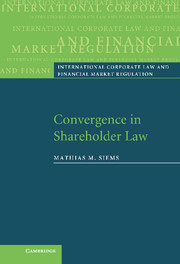Book contents
- Frontmatter
- Contents
- Preface and acknowledgments
- List of abbreviations
- Table of cases
- Table of legislation
- Introduction
- PART I The object and course of the investigation
- PART II The status quo of convergence
- 2 Legal bases
- 3 Bases for a shareholder typology
- 4 The ‘shareholder as such’
- 5 The shareholder in the power structure of the company
- 6 Conclusions to Part II
- PART III Developmental trends and patterns
- PART IV Conclusion
- References
- Index
4 - The ‘shareholder as such’
Published online by Cambridge University Press: 15 December 2009
- Frontmatter
- Contents
- Preface and acknowledgments
- List of abbreviations
- Table of cases
- Table of legislation
- Introduction
- PART I The object and course of the investigation
- PART II The status quo of convergence
- 2 Legal bases
- 3 Bases for a shareholder typology
- 4 The ‘shareholder as such’
- 5 The shareholder in the power structure of the company
- 6 Conclusions to Part II
- PART III Developmental trends and patterns
- PART IV Conclusion
- References
- Index
Summary
The term ‘shareholder as such’ refers to those elements in the shareholder's position that relate to his typical original rights. These involve, first, the expectation that his investment will pay off at some time in the future, through selling his shares or receiving dividends (section I below: ‘the profit-oriented shareholder’). Secondly, shareholders, by contrast with creditors, typically have a legal entitlement to become active through their vote (section II below: ‘the active shareholder’). Both options are enhanced by the information the shareholders receive, or must furnish about themselves (sections III and IV: ‘the informed shareholder’; ‘the anonymous shareholder’). For, if a shareholder had no information about, say, the company's situation or other shareholders, he would have difficulty deciding when to become active or to realize his profit. In contradistinction to these aspects, when it comes to the ‘shareholder's position in the power structure of the company’ (Ch. 5), the focus shifts to the shareholder's relationship to other people or institutions of the company (‘the deciding shareholder’, ‘the protected shareholder’, ‘the litigating shareholder’).
The profit-oriented shareholder
The profit-oriented shareholder is interested, first, in avoiding claims being made on him for the company's expenditure (subsection 1 below). Secondly, he wants his investment to bring a profit in the short, medium or long term (subsections 2 and 3 below) – although he is not certain of this profit expectation, since investment in a firm's equity is closely tied to the firm's fate and not limited to the credit risk.
- Type
- Chapter
- Information
- Convergence in Shareholder Law , pp. 68 - 148Publisher: Cambridge University PressPrint publication year: 2007

